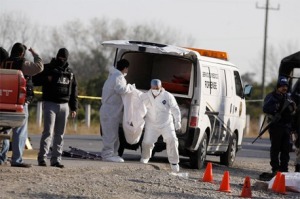
A document from the San Fernando case file says that police delivered detainees into the hands of the Los Zetas drug gang.
Yesterday we published the first document from the Mexican prosecutor’s case file on the 2011 San Fernando massacre. The “Tarjeta Informativa” from the Subprocuraduría Especializada en Investigación de Delincuencia Organizada (SIEDO or SEIDO) details a number of troubling allegations leveled against members of the San Fernando, Tamaulipas, police department by members of Los Zetas, the criminal group believed to be responsible for the deaths of hundreds of migrants discovered in mass graves in 2011.
Captured Zetas members told federal investigators that police acted as “lookouts” [“halconeo”] for the group, helped with “the interception of persons,” and otherwise turned a blind eye to the Zetas’ illegal activities. One of the 17 police officials detained as part of the investigation backed up this account:
I know that police and transit officials in San Fernando help the Zetas organization, because rather than take detainees to the Pentágano, which is to say the municipal jail, they would deliver them to the Zetas. The truest one [“mero bueno”] is an elderly police officer and another named Óscar Jaramillo, who receive money from the organization to collaborate.
If the facts surrounding the San Fernando case seem eerily familiar, it is beacuse they follow pattern seen over and over again in recent years. Like the September 2014 Ayotzinapa case–in which police allied with a local criminal group are alleged to have been involved in the forced disappearance of 43 student-teachers–the 2010 and 2011 San Fernando massacres are symptomatic of the dirty war of corruption and narcopolitics that has consumed parts of Mexico over the last decade. Killings like these are disturbingly common, and the forces behind the mayhem—usually drug cartels counting on the collaboration of, at a minimum, local police—are remarkably consistent.
You can read the entire post over at the National Security Archive, where we’ve also posted a set of 43 declassified (and Wikileaked) documents on police corruption in Mexico. But there are lots of other place to read about this story, including:
- Marcela Turati’s excellent piece in Proceso, “San Fernando-Ayotzinapa: las similitudes” (“San Fernando-Ayotzinapa: the similarities”)
- Jesse Franzblau’s detailed analysis for NACLA of the sad history of impunity and state complicity in the crimes of Mexican drug gangs
- A live analysis of the case with Carmen Aristegui on Noticias MVS
- A tight summary of the case and our transparency efforts from AFP (and published by CNN Mexico)
- Coverage in El Financiero, including some comments from Ana Lorena Delgadillo, lead attorney in a related access to information case now pending before Mexico’s Supreme Court
Pingback: Ayotzinapa and Beyond: Documenting the Drug War’s Hidden Atrocities | Migration Declassified
Pingback: RESEARCH DOCUMENT : US: Mexico Mass Graves Raise “Alarming Questions” about Government “Complicity” in September 2014 Cartel Killings | Derin Strateji
Pingback: US: Mexico Mass Graves Raise “Alarming Questions” about Government “Complicity” in September 2014 Cartel Killings | universalpluspepe
Pingback: US: Mexico Mass Graves Raise “Alarming Questions” about Government “Complicity” in September 2014 Cartel Killings State Department Quietly Suspended Aid to Army Unit Responsible for June 2014 Tlatlaya Massacre National Security Arc